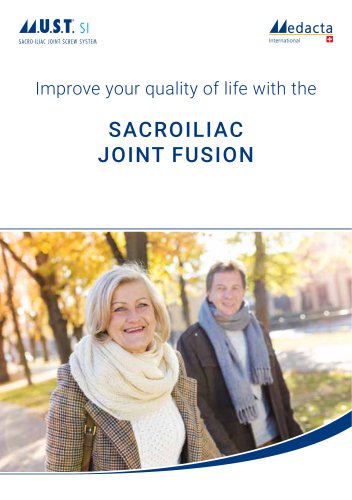
Catalog excerpts
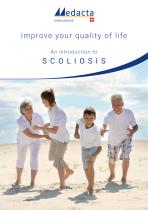
Improve your quality of life An in troduction to
Open the catalog to page 1
Dear reader, Medacta International is pleased to provide you basic guidelines to help you and your family gain the best possible understanding of this pathology. Please consider this booklet as only a resource. If you need additional information please ask your doctor. Always follow your surgeon’s instructions, even when they differ from those outlined in this booklet.
Open the catalog to page 2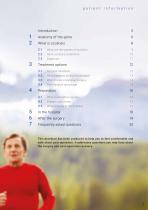
Anatomy of the spine What is scoliosis What are the causes of scoliosis Adult scoliosis symptoms Surgical treatment What happens during the surgery? Why choose a MySpine surgery The MySpine advantage What to do before surgery Prepare your home What to bring to the hospital In the hospital 18 After the surgery 19 Frequently asked questions 20 This brochure has been produced to help you to feel comfortable and safe about your operation. It addresses questions you may have about the surgery and post-operative recovery.
Open the catalog to page 3
IN T R OD U CT ION The Spine, also known as the backbone or vertebral column, consists of 33 interlocking bones positioned on top of each other. It is made up of 24 separate bones interspaced with the “intervertebral discs”, with the sacrum (5 fused bones) and the coccyx (4 fused bones) at the base. The spine is a complex combination of interconnected bones, tendons, muscles, ligaments and nerves, any of which can become injured, misaligned or damaged leading to dysfunction. The spine provides the main structural support of the body allowing mobility, the ability to walk upright, and it...
Open the catalog to page 5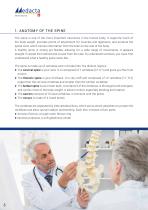
1. A N ATO M Y O F T H E S PIN E The spine is one of the most important structures in the human body. It supports much of the body weight, provides points of attachment for muscles and ligaments, and protects the spinal cord, which carries information from the brain to the rest of the body. A healthy spine is strong yet flexible, allowing for a wide range of movements. It appears straight if viewed from behind and curved from the side. To understand scoliosis, you must first understand what a healthy spine looks like. The spine is made up of vertebrae and is divided into five distinct...
Open the catalog to page 6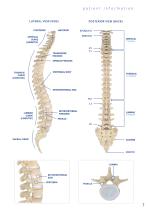
LATERAL VIEW (SIDE) POSTERIOR POSTERIOR VIEW (BACK) CERVICAL CURVE (LORDOTIC) TRANSVERSE PROCESS SPINOUS PROCESS THORACIC CURVE (KYPHOTIC) VERTEBRAL BODY INTERVERTEBRAL DISC LUMBAR CURVE (LORDOTIC) SACRAL CURVE INTERVERTEBRAL DISC VERTEBRA
Open the catalog to page 7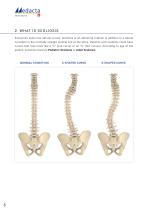
2 . W H AT I S S C O L I O S I S Everyone’s spine has natural curves. Scoliosis is an abnormal rotation in addition to a lateral curvature in the normally straight vertical line of the spine. Patients with scoliosis could have curves that look more like a “C” (one curve) or an “S” (two curves). According to age of the patient, scoliosis could be Pediatric Scoliosis or Adult Scoliosis. NORMAL CONDITION C-SHAPED CURVE
Open the catalog to page 8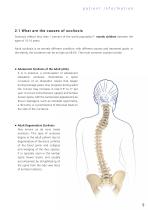
2 .1 W hat are the c auses of sc oliosis Scoliosis affects less than 1 percent of the world population [1], mostly children between the ages of 10-16 years. Adult scoliosis is an entirely different condition, with different causes and treatment goals. In the elderly, the incidence can be as high as 68.6%. The most common causes include: ■ Adolescent Scoliosis of the Adult (ASA) It is in essence, a continuation of adolescent idiopathic scoliosis. Sometimes a spine curvature of an idiopathic nature that began during teenage years may progress during adult life. Curves may increase in size...
Open the catalog to page 9
2 . 2 Ad ul t sc oliosis s y m p t o m s Both types of adult scoliosis can progress over time. If the curves reach 30 to 40 degrees, the deformity may be noticed by a hump or prominence in the area of the spine that is involved. Adults may have more symptoms than teens because of degeneration in discs and joints leading to narrowing of the openings for the spinal cord and nerves (spinal stenosis). Adult patients may have a variety of symptoms, which can lead to gradual loss of function: ■ Low back pain and stiffness are the 2 most common symptoms[2] ■ Numbness, cramping, and shooting pain...
Open the catalog to page 10
2 .3 Diag nosis Any medical diagnosis usually commences with a thorough discussion of the medical history followed by a physical examination. In the case of scoliosis, your doctor will look at the spine and examine for any signs of scoliosis. You may be referred to have a series of X-rays, MRI or CT scans. A CT or “Computed Tomography” scan, otherwise known as a CAT scan, uses X-Rays to produce cross-sectional images of the structures inside your body. During the scan, the machine spins around the body and sends the images to a computer monitor. A radiologist reviews the images and prepares...
Open the catalog to page 11
3. T R E AT M E N T O P T I O N S In 90 percent of cases, scoliotic curves are mild and do not require active treatment[3]. Non-operative treatment is preferred, including periodic observation, pain relievers and physical therapy. The most important factors to determine the treatment are: ■ Severity and the location of the curve ■ Age, gender and physical maturity ■ Associated symptoms It is very important to monitor curves in adolescent patient, to prevent the progression of the pathology. In adolescent with moderate curves, bracing could be an appropriate treatment option to prevent...
Open the catalog to page 12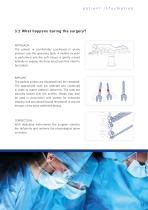
APPROACH The patient is comfortably positioned in prone position over the operating table. A midline incision is performed and the soft tissue is gently moved laterally to expose the bony structures that need to be treated. IMPLANT The pedicle screws are implanted into the vertebrae. The appropriate rods are selected and contoured in order to match patient’s deformity. The rods are securely locked over the screws. Hooks may also be used in conjunction with screws for enhanced stability, and are placed around the pedicle or around the part of the bone called the lamina. CORRECTION With...
Open the catalog to page 13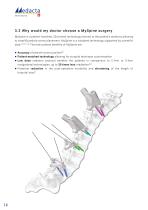
3.3 W hy woul d my d o c to r c h oose a M y S pi ne su rge r y MySpine is a patient-matched, 3D printed technology tailored to the patient’s anatomy allowing to simplify pedicle screw placement. MySpine is a validated technology supported by scientific data.[4,5,6,7,8,9] The main patient benefits of MySpine are: ■ Accuracy of pedicle screw position[5] ■ Patient-matched technology allowing for surgical technique customisation ■ Low dose radiation protocol benefits the patients in comparison to C-Arm or O-Arm navigational technologies: up to 30 times less irradiation![4] ■ Potential...
Open the catalog to page 14All Medacta catalogs and technical brochures
-
PowerSuture leaflet
2 Pages
-
PowerKnot leaflet
2 Pages
-
MectaQTH leaflet
2 Pages
-
FairFix leaflet
2 Pages
-
M-ARS ACL leaflet
2 Pages
-
M.U.S.T. SI Patient leaflet
8 Pages
-
MySpine MC Patient brochure
12 Pages
-
Sterile Implants leaflet
10 Pages
-
M.U.S.T. leaflet
2 Pages
-
M.U.S.T. MIS leaflet
2 Pages
-
M.U.S.T. Mini leaflet
2 Pages
-
MectaLIF leaflet
2 Pages
-
MectaLIF Anterior leaflet
2 Pages
-
MectaLIF TIPEEK leaflet
2 Pages
-
Mecta-C leaflet
2 Pages
-
Mecta-C Stand Alone leaflet
4 Pages
-
MySpine S2AI leaflet
4 Pages
-
MySpine MC leaflet
2 Pages
-
MySpine leaflet
2 Pages
-
HIGHCROSS leaflet
2 Pages
-
GASTON leaflet
2 Pages
-
MYHIP leaflet
2 Pages
-
M-VIZION leaflet
5 Pages
-
MPACT System leaflet
2 Pages
-
VERSAFITCUP CC TRIO leaflet
2 Pages
-
MINIMAX leaflet
2 Pages
-
SMS leaflet
3 Pages
-
MASTERLOC leaflet
2 Pages
-
QUADRA System leaflet
2 Pages
-
QUADRA-P System leaflet
4 Pages
-
AMISTEM System leaflet
2 Pages
-
AMISTEM-P leaflet
2 Pages
-
AMIS EXPERIENCE brochure
28 Pages
-
MYSHOULDER patient leaflet
8 Pages
-
MYSHOULDER leaflet
4 Pages
-
MOTO Medial patient leaflet
8 Pages
-
GMK Sphere patient leaflet
8 Pages
-
MyKnee patient leaflet
16 Pages
-
Efficiency KneePack flyer
2 Pages
-
GMK Revision System leaflet
2 Pages
-
MOTO MEDIAL leaflet
4 Pages
-
GMK UNI Anatomic leaflet
2 Pages
-
GMK Efficiency leaflet
2 Pages
-
MyKnee leaflet
4 Pages
-
GMK Primary leaflet
2 Pages
-
GMK Sphere leaflet
3 Pages








